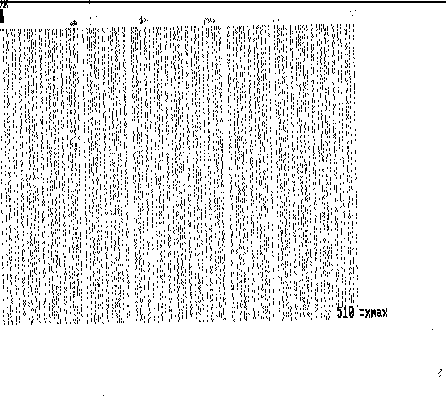 Fig. 3e (above), xmax=510
Fig. 3e (above), xmax=510
I apologize for the terrible quality of the graphics below. They were scanned in from 10-year-old printouts; some were then compressed. But the visual effect of the modern computer-generating tools available to me right now are not as good. All criticisms accepted, but I am concentrating on the merit of the concepts involved, not on the technicalities of its presentation.
GRAPHIC REPRESENTATIONS OF THE DISTRIBUTION OF THE PRIME NUMBERS or WHY 11 AND 20 ARE AS ETERNAL AS PI (WELL, ALMOST) by Brendan J. Welch University of Massachusetts at Lowell Lowell, Mass. 01854 BRENDAN_WELCH@UML.EDU © 1986 May & 1996 April One way of finding the prime numbers is to use the ancient Sieve of Eratosthenes: a list is made of all the counting numbers, up to the highest desired or practical number; then all the multiples of 2 are eliminated, starting at 4; then all the multiples of 3 are eliminated, starting at 6; the process is repeated until all possible eliminations have taken place (which is arrived at with the multiples of the square root of the highest counting number used). A modern computerized version of the Sieve has already become one of the traditional ways of evaluating and comparing computers, because it is a lengthy, cpu-intensive process. As a casual observer, I thought that it would be interesting to list the primes graphically, for a variety of reasons. Although it probably has been done before, it seemed to me that the way in which the numbers die out as you march toward infinity would make a unique pattern which could be used to communicate with other civilizations. I had the preconception that such a picture would look quite ragged or straggly as you marched out toward infinity; I had the humorous ideas that maybe with some stretch of the imagination, it would come out looking something like the gold-plated picture plaque (shown in Figure 1) used by Carl Sagan on the Pioneer 10, or perhaps as a cosmic peace symbol (Figure 2). I say humorous, because actually it would be quite upsetting if some "local" earthly symbol would have an eternal, mathematical, galactic equivalent according to the Laws of Einstein that "physics is physics" no matter where you reside in the Universe, or if God and quantum mechanics had played some giant trick on us. ?????? placeholder here for plaque (Fig.1) currently at end of document to save your time. Figure 2 (below), explained at Figure 7
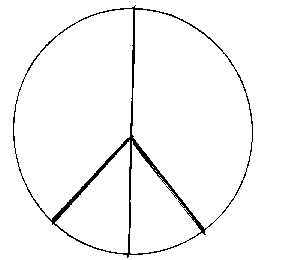 Fig. 2 PEACE
Fig. 2 PEACE
In any case, it would be nice to have some universally applicable
"thing", whether it be the number pi, or the binary counting
system, or the angle that the oxygen atoms make with the hydrogen
atom in a molecule of water.
One difficulty, on whatever planet or galaxy you reside, and
whatever the size of your eyeball (or other optical sensor), is
that presumably it is impractical to represent the number line
from 1 to infinity. Certainly one approach toward compressing the
picture, such as on the printed page, would be to stop your scan
of the number line, as you go from whatever constitutes
left-to-right on your planet, and place the next group of numbers
"below" the first group, just as we in the English language have
agreed to have our written documents extend perhaps 80 characters
across, and then place the next part of our sentence below and all
the way to the left of where we just cut it off. This is, of
course, the same way a television camera scans a scene.
The inhabitants of different planets, or even of the same planet,
would probably disagree, maybe violently, about what number other
than 80 would constitute a "natural" or "pleasing" or "eternal" or
"universal" way. My approach, then, was to try several different
numbers, and see which ones proved tractable, natural,
mathematically revealing, or even just plain pretty or funny.
This was all done, of course, on a computer. Some observations:
---it proved surprisingly easy to program, using Basic.
---you can represent a lot of numbers, even on a cheap screen; my
first try was for 640 x 200 = 128,000.
---the biggest surprise was that there are a heck of a lot of
primes; the math books say it goes as x/ln x, but I will just say
that the bottom line of the screen looks almost as bright as the
top line. An impromptu rule of thumb is that something like 10%
of the counting numbers are primes; this is roughly true over a
very wide range, falling off to about 5% by the time you count to
a billion.
---because the average home computer today has as much computing
and graphic power as the large computers of a few years ago, maybe
I can learn something the professionals don't already know, or at
least have not popularized among themselves.
---if you have an imagination, or like to look at clouds and see
pictures in them, you can have a ball (or, they will send the men
in white jackets to cart you away); I have seen such things as a
baby boy (the child Jesus?), a heart, and an anchor by squinting
at just a few hundred numbers when they have been displayed
appropriately. Rorschach, beware.
In the pictures below, each one has an associated cutoff number of
"xmax" points per line. If xmax = 100, for example, then the
first line contains the numbers 0 thru 99, the next line contains
100 thru 199, and we plot as many lines as can fit on the screen
of the particular computer (either 200 or 800). A dot
means a number which is prime. Thus the upper left corner
contains the early primes 1, 2, 3, 5, 7, 11, 13, 17, etc. (except
that I think I left out the first one, 1, to satisfy some
purists who said 1 is not a prime number (?)).
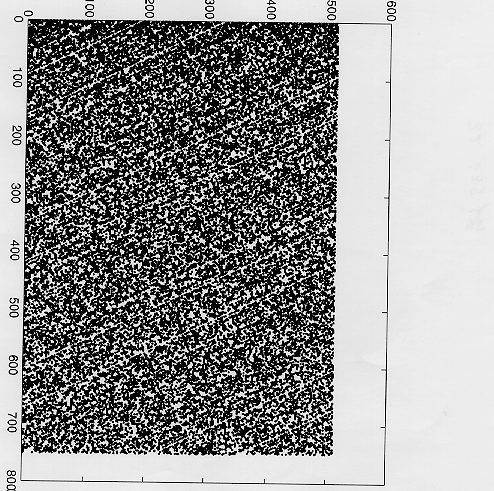 BIGGEST, xmax=512, using Matlab
instead of Basic. =Fig. 3a (above).
BIGGEST, xmax=512, using Matlab
instead of Basic. =Fig. 3a (above).
Above are all the primes up to the number 384,000. Notice the diagonal striations, which I think are due to the many multiples of the smaller primes.
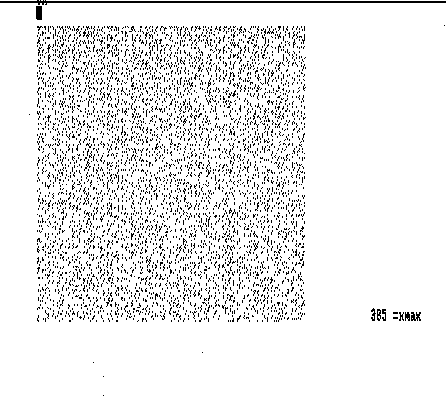 Fig. 3b (above), xmax=385
Fig. 3b (above), xmax=385
 Fig. 3e (above), xmax=510
Fig. 3e (above), xmax=510
Multiples of 2,3,5, and 17 cause the noticeable banding.
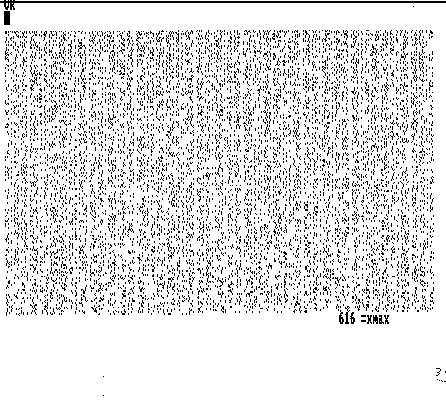 Fig. 3g (above), xmax=616
Fig. 3g (above), xmax=616
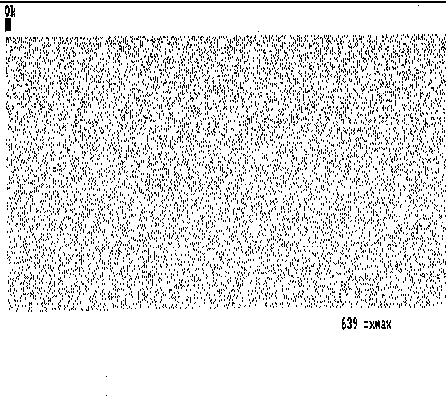 Fig. 3h (above), xmax=639
Fig. 3h (above), xmax=639
Tilt your head 90 degrees toward your right shoulder, until I straighten out this next one. Squint.
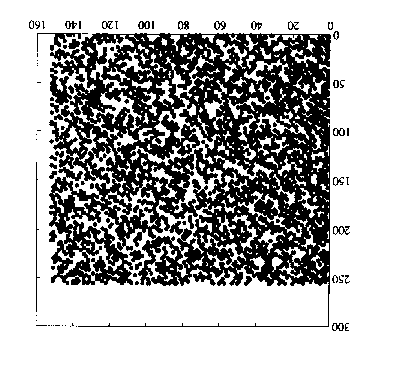 BULL, xmax=256
BULL, xmax=256 Several people can see a bull above, horns between 100 and 150. xmax=256
Ah, life is not simple. How can we compress more information? If
we were sending a radio signal consisting of a little burst of
energy representing each binary bit of each prime number, we would
be wasting a lot of significant digits (and time, and energy) on
essentially repetitive information. It would be easier just to
send successively the differences between successive numbers.
So the next thing I did was something which can be assailed as
being arbitrary, artifical, or culture-dependent. Presuming that
these alien beings are as oriented to two dimensions as we are, I
grouped the differences between the primes in groups of four;
within each group, the sequence of plotting is up, left, down,
right; thus the sequence of prime numbers is wrapped around in a
rectangular ball. What is surprising is the unusual picture which
resulted. If any alien civilization thinks at all like we (I?)
do, they certainly would recognize this picture as being singular,
eternal, and mathematically beautiful.
Figure 4 (below),
rectangular derivs
![[rectangles]](fig4.gif)
But I was not satisfied to believe that a raster type of
left-to-right scan was the only way to communicate across time,
space, and biological types. Another way of compressing data from
a single, infinitely extended, straight number line would be to
wind the number line around in a spiral. Furthermore, we could
communicate another "eternal" idea, that of radian measure.
Consider the well-known mathematical spiral, r = theta.
If we place a dot at each counting number, where a value of 1 = 1
radian = 57.925 degrees, then we get a picture like this (it has
been compressed radially by a factor of 16, both to fit in more
numbers, and to show its structure of radiating spiral arms more
distinctly; also, it is upsidedown from the traditional textbook
picture because +y is downwards on my computer screen):
Figure 5 (below)
spiral of ALL counting numbers (i.e. the integers)
44 arms compressed by a factor of 16
![[spiral-all]](fig5.gif)
Even more surprising is the picture which is left after the Sieve
program has removed the various multiples! What could be more
appropriate to communicate across the galaxies than a picture of
the most "prime" or "eternal" galaxy?
Figure 6 (my favorite)
the spiral "galaxy"
compressed by factor of 128
![[spirals]](fig6.gif)
The empty white bands were even more impressive when I first saw them,
as a road of black, on a green-screen monitor, giving the galaxy its
distinctive form. I thought it might be due to the fact that there
are no even numbers which are primes, but in our continuing round
of surprises, this is not the case.
In order to understand what has happened, it is necessary to look
back at Figure 5, containing all the counting numbers in spiral
form. Note that after every count of 6, we get a circular slippage
of 16.225 degrees, due to the difference between the 6.28 (=2*pi)
radians of once around the circle and the 6 whole numbers we can
fit into one rotation (6.28 - 6 = .28 rad = 16.225 degrees). Also
note that after 22 trips around the circle, we have almost
perfectly come back to where we started, since 22 X 16.225 =
356.95 or almost 360 degrees. But it turns out that there are 44
radiating spiral arms, not 22. By hindsight, this is explainable
as follows. When you get halfway thru your 22 trips, the slippage
puts another number halfway between your expected 22 arms; partly
because of the radial compression of the picture, partly because
of the fairly wide separation of the existing arms, and partly
because of the lines which the combination of eye and mind tend to
follow, another spiral arm is generated approximately 180 degrees
away. Note that these 44 spiral arms have "nothing to do" with
the single, tightly wound spiral arm generated by the original
formula, r = theta. You have generated a pattern which has no
points actually connected, and there are many ways the eye can
look at such a pattern and generate a mental or visual connection.
As you walk out any one of the radial spiral arms, the numbers you
encounter there are spaced 44 away from the previous number; your
eye will also tend to follow another set of lines, which seem to
run almost circularly, whose number spacing is 25.
When the Sieve program erases the multiples of 2, it immediately
removes every alternating arm, leaving a fairly symmetrical
picture with 22 arms. As the multiples of 3, 5, 7 etc. remove
other points, (you might even say removes them "randomly"), some
arms may seem to be hit a little harder than others, but the basic
structure of 22 arms is still visible. The next surprise, perhaps
the biggest of the whole experiment, is that when the multiples of
11 are removed, the job is completed of totally removing 2 more
arms. Sure it is easy to explain after the fact; the factors of
44 are 2,2, and 11. The result is a picture of a "galaxy" with 20
arms; they are spaced every 16.225 degrees; the "missing" arms
give the galaxy the look of a barred spiral, a classic
astronomical category of galaxy.
But don't give up yet, folks. Do you remember up above, where we
fed the spacing between the primes into a rectangularly-based
display? Let's do the same thing again, and feed those same
numbers into the spiral display program. The resulting picture,
shown below, except with no radial compression, gives another
"eternal" picture, unwittingly adopted by the U.S. Dept. of
Transportation as a logo. Maybe Eratosthenes could be credited
with contributing the letter lambda to the Greek alphabet.
And, I have found that there does exist some sort of cosmic version
of the "peace symbol" of Figure 2.
Figure 7 (below), lambda
![[lambda]](fig7.gif)
There is a corollary of Murphy's Law which says that anything can
be made to work (or in this case, can be explained) if you kludge
at it long enough. There are only 6 possible radials at this
magnification of the spiral (your eye is not connecting the same
radial or circular lines as it did above); prime numbers are
always odd; thus their differences are always even; many of the
early primes have differences of 2, 4, or 6 (or of 8, 10, or 12,
etc.). Thus there will be 3 spiral arms, containing even numbers,
whose bright points are lighted up by many (redundant)
contributions of rather small numbers.
Figure 1 below is the plaque aboard the Pioneer 10 spacecraft. © NASA.
(Moved here to the end of the document to prevent slow loading at beginning.)
![[plaque]](plaque.gif)